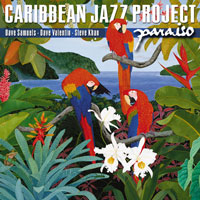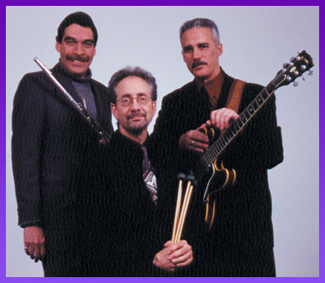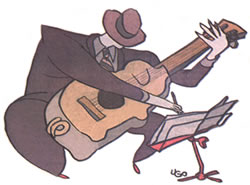

|
Soundclip: |
|
|
|
The roots of "Maluco" actually lie in an old 'demo' I sequenced many years ago when preparing for the play-along CD of "CONTEMPORARY CHORD KHANCEPTS." I wanted to create a rhythmic groove in 3/4 but one which would have an even-8th-note feel and could appeal to both jazz-oriented players as well as 'rock,' 'pop,' and 'R&B' players. On the 'blue' play-along CD, this groove appears on tracks [19] & [20]. As the bass line only outlines roots(G) and fifths(D), the harmonic colors(major, minor, or dominant) can be determined by the player, and it is this very notion which gives rise to much of the harmonic movement contained within "Maluco."  As I've often done in the past, the [I] sections are designed to define the 'attitude' and groove of the entire piece. Again, as I knew the tune was to be recorded by the Caribbean Jazz Project which would feature the brilliant Dave Samuels on marimba and vibes, I decided to write all the chordal sections of the lead sheet an octave down from where I would normally write them were it only for the guitar. Though I suppose it could easily be said that the voicings seem to be indicating that we are in a Gm7 harmonic area, there is also an ambiguous harmonic quality to all of it which I like. During the rehearsals, and during one run-through, I made an error and accidentally played an alternative voicing in bars 3 and 7 of [I]. Initially I had written a 3-note voicing which simply had G-A-D(spelling up) as the only notes. In error, I played a voicing which had A-C-D in it, and this, coupled with the marimba playing the three-note voicing I had originally written, gave everything a much fuller and more interesting sonority. And, more than this, added to the harmonic ambiguity as you now had a G-A-C-D voicing, all over the 'G'-pedal, and not a 3rd or 7th in sight! So, with this 'resolution' we are not in minor, major or dominant. In the final version, Dave Samuels plays the full four-note voicing you now see. As I've often done in the past, the [I] sections are designed to define the 'attitude' and groove of the entire piece. Again, as I knew the tune was to be recorded by the Caribbean Jazz Project which would feature the brilliant Dave Samuels on marimba and vibes, I decided to write all the chordal sections of the lead sheet an octave down from where I would normally write them were it only for the guitar. Though I suppose it could easily be said that the voicings seem to be indicating that we are in a Gm7 harmonic area, there is also an ambiguous harmonic quality to all of it which I like. During the rehearsals, and during one run-through, I made an error and accidentally played an alternative voicing in bars 3 and 7 of [I]. Initially I had written a 3-note voicing which simply had G-A-D(spelling up) as the only notes. In error, I played a voicing which had A-C-D in it, and this, coupled with the marimba playing the three-note voicing I had originally written, gave everything a much fuller and more interesting sonority. And, more than this, added to the harmonic ambiguity as you now had a G-A-C-D voicing, all over the 'G'-pedal, and not a 3rd or 7th in sight! So, with this 'resolution' we are not in minor, major or dominant. In the final version, Dave Samuels plays the full four-note voicing you now see.
As bassist Rubén Rodríguez joked after the first run-through of the tune, "Steve, did you go out and have some Middle Eastern food before you wrote this?" I can only say that I guess this is what the melody at [A] and [B] sounded like to him. The melody at [A] also has a rather ambiguous harmonic quality which is introduced quickly as you hear both 'B'-naturals and Bb's in each phrase. Also each 8-bar phrase ends with a small melodic unit where the root, 'G' is surrounded by an Ab and then a 'B'-natural, which further adds to the harmonic uncertainty. One thing I'd like to address is the way timbalero Luisito Quintero approached this piece. There is a very fundamental cowbell pattern which is usually played in pieces which are in 3/4 or 6/8. However, for this tune, Luisito decided to play this pattern on the "cha-cha" bell rather than on the "mambo" bell(which, in truth, I would have preferred). The rhythms of the cowbell and the conga pattern were to be glued together by the güiro which was to play an "Abakuá" counter-rhythm. This gives the impression that a pattern in '2' is being played against or over the fundamental rhythm in '3.' As it often turns out, there are times, during the rehearsal and recording process, where one is so concerned with executing their own responsibilities as a player to the composition that one cannot see/hear other details within the 'bigger picture.' In this case, I am totally guilty of that. Though I couldn't put my finger on it at the time, something 'felt strange' to me as we were rehearsing and recording the piece, but, I just could not figure it out or verbalize it until we were long into the mixing process. By then, of course, it was too late to change anything. Three elements contributed to the "strangeness" I felt. [1] the 'cha-cha' bell as opposed to the 'mambo' bell; [2] The bass tumbao was not truly agreed upon and; [3] Richie Flores opted to play an odd and contrasting pattern on the congas. With regards to the bass tumbao, I had written two bass 'sketches' for Rubén, and he tried to incorporate both of them at different times, but, the best groove occurs later in the piece when he opts for playing more what just "feels right to him." And it is that pattern which would probably have been best throughout. Since the recording, I haven't really had the opportunity to discuss the congas, and the pattern with Richie, but, when we prepare to perform the piece "live," I'm going to ask him if he could play a conga pattern which is a little more "up and down" feeling. I guess the best way to put it is "a pattern with more even-8th-notes in a straight flow."  [I2] signals a harmonic shift even though the rhythm remains the same, and the bass tumbao is fundamentally unchanged. Here we shift from what was once a harmonic area which flirted with G7 or Gm7 and we make a change to a more Phrygian sound which is produced by playing, what are essentially, Fm(7) voicings over the 'G'-pedal. However, even with this being understood, I heard resolutions in bar 4 of each phrase to a simple G7 voicing. So, harmonically where are we?
[I2] signals a harmonic shift even though the rhythm remains the same, and the bass tumbao is fundamentally unchanged. Here we shift from what was once a harmonic area which flirted with G7 or Gm7 and we make a change to a more Phrygian sound which is produced by playing, what are essentially, Fm(7) voicings over the 'G'-pedal. However, even with this being understood, I heard resolutions in bar 4 of each phrase to a simple G7 voicing. So, harmonically where are we?
The melody which appears in [B] is obviously a development of what appeared in [A] but with melodic twists to incorporate more Ab's and Eb's which would give us that G-Phrygian(F-Dorian) feeling. As opposed to the melodies in [A], here, phrases tend to end by accentuating the sense of Ab going to Bb and then to 'G.' But, in the end of bar 7, the melodic cadence is just as it was in bar 7 of [A]. As this piece is performed, [B] only appears once in the entire tune. Section [C] offers us our third harmonic area existing over the same bass line, though here we make shifts to a 'B'-major area as a striking contrast. Initially, this section was only written with the chordal voicings you hear the guitar and marimba playing, but, as the recording approached, I began to hear additional linear melodies which would join the chordal melodies. So, I added melodic material to the flute part and it is this which, in my opinion, glues everything together. In all likelihood, when "Maluco" is performed live, the marimba/vibes will mark these additional notes as well. Rhythmically, this section introduces Luisito's Venezuelan-style maracas. When I think of all the wonderful folkloric music I've been lucky enough to hear during my time in Venezuela, I, like so many musicians from North America, Europe, and even the Caribbean, have been totally knocked-out and fascinated by the style and flare of the maraqueros(the maracas players). What they do is truly unique and wondrous, especially how they indicate the shifts between 3/4 and 6/8. Wow! [C2] serves as the final transition piece back to our [I] sections, the eventual solos and the melodic return of [A]. In hindsight, I would have to say that this little section bears the influence of my longtime friend and former bandleader, trumpeter Randy Brecker. One of the great elements of his writing style is that he often takes a melody which, if it were to exist apart from the harmony, might almost sound like a children's song or nursery rhyme. The harmonization of this simple melody brings together Brecker-esque elements when chords like C/Db and Bb/Gb(GbMaj7#5) appear. When we finally arrive at the consonant sound of Cb/Db(a simple Db dominant sound), the maracas disappear, and the güiro returns along with the cowbell pattern from the timbales. Yet, the transition chord back to our 'G'-pedal area is a D/Bb(BbMaj7#5). Obviously, the 'D' part of that chord is what gives it the V7 character, enough to push it towards a resolution. For improvising/soloing over this tune, I wanted to create a small form, [D], which would mirror the harmonic elements of the tune in miniature. As it turned out, the form almost has a 'blues' structure to it with the Fm7/G(the Phrygian area) functioning as the IV chord might. This little form should generally be 'open' and its length determined by the soloist. When the soloist is ready to move the piece forward, he simply would "cue" [D2] and the solo continues over new harmonic material which is reminiscent of the last 6 bars of [C] and gives a continuity to the solo section as a whole. Between each solo, [C2] reappears and [I3] is played before the next solo begins. After the last solo, the tune moves ahead to [I4] which is only 8 bars, like most of the other [I] sections with the exception of [I](the first time it appears at the top of the tune) and [I2].  Rather than restating the major themes of the piece at great length, I chose to just play what is fundamentally [A], now labeled as [A3] because a small [Tag] has been added for a dramatic ending. Though I really just heard the chordal punctuations/accents, which drive the tune home, as harmonic sounds, let me offer what might serve as a harmonic explanation of why they work well. The first 'hit' could be described as a Db/G sound. But, if one were to extend the time spent on the chord(or sound), you might come to hear it as a C-Phrygian/G(the 5th of the that chord). In other words, the Db-triad is now seen as part of a Bbm7/C and this is what gives you that Phrygian sound. The second chordal hit, one bar before the end, is Eb/B sound(though it could have just as easily been spelled as D#/B or Bmaj7#5). Here it is almost as if we have created some strange kind of Plagal cadence(iv-I), because you could come to view the Eb-triad as part of a Cm7(the iv of 'G') and therefore the resolution would make some reasonable harmonic sense. The final chordal resolution is solid but is a G(add2) voicing which could be harmonically anything: major, minor, dominant, or suspended. Again, it's ambiguous just as so much of the piece was before it.
Rather than restating the major themes of the piece at great length, I chose to just play what is fundamentally [A], now labeled as [A3] because a small [Tag] has been added for a dramatic ending. Though I really just heard the chordal punctuations/accents, which drive the tune home, as harmonic sounds, let me offer what might serve as a harmonic explanation of why they work well. The first 'hit' could be described as a Db/G sound. But, if one were to extend the time spent on the chord(or sound), you might come to hear it as a C-Phrygian/G(the 5th of the that chord). In other words, the Db-triad is now seen as part of a Bbm7/C and this is what gives you that Phrygian sound. The second chordal hit, one bar before the end, is Eb/B sound(though it could have just as easily been spelled as D#/B or Bmaj7#5). Here it is almost as if we have created some strange kind of Plagal cadence(iv-I), because you could come to view the Eb-triad as part of a Cm7(the iv of 'G') and therefore the resolution would make some reasonable harmonic sense. The final chordal resolution is solid but is a G(add2) voicing which could be harmonically anything: major, minor, dominant, or suspended. Again, it's ambiguous just as so much of the piece was before it.
Finally, so just what does "Maluco" mean? Well, to the best of my knowledge, and powers to explain it, "Maluco" is a word particular to Venezuela. I guess it's a colloquial extension of the usage of "malo"....which is something like saying "bad boy!" So, there you have it, that's the best I can do, at least right now. As always, I am hoping that this discussion of the composition and the process has only added to your enjoyment of the tune. Thanks so much for continuing to visit us at KHAN'S KORNER. Photo by: Richard Laird Guitarist drawing by: Ugo from "EL NACIONAL" Caracas, Venezuela] |
| KORNER 2 | HOME |